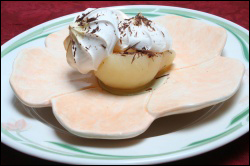If you blame a hectic schedule for the lack of whole grains in your diet, that is a thin excuse these days. There are many quick, enjoyable ways of including them. At breakfast, instant oatmeal and other ready-to-eat whole-grain cereals all count. At lunch, a sandwich on any kind of 100 percent whole-grain toast provides two servings of whole grain. For snacks, there are whole rye and whole-wheat crackers enticing enough to eat like potato chips.
You live on take-out? Order pizza with whole-wheat crust when it is available. It is especially good topped with broccoli and spinach. For Tex-Mex, ask for a whole-wheat tortilla for your burrito. If you like Middle Eastern food, have tabbouleh. It is made with bulgur, which is precooked whole wheat. Wild rice is a whole grain, one being used more and more in take-out salads. So are nutty-tasting wheat berries, another form of whole wheat that is especially delicious tossed with dried cherries or cranberries and an herb vinaigrette.
When you dine out, whole grains are often found in side dishes. At Italian restaurants, they even take the center of the plate. Your favorite trattoria surely serves polenta, cornmeal made from whole corn. Italian restaurants may also be a great place to discover farro, a kind of whole wheat used to make an earthy, brown pasta that is especially delicious topped with intensely flavored wild mushroom sauce or garlic-spiked sauteed broccoli rabe.
At home, you can enjoy whole-wheat pasta and bulgur, too. Bulgur needs only to soak in boiling water or broth like couscous. But unlike couscous (usually sold in a form made from refined flour), bulgur is a whole grain.
If you think whole grains are not elegant enough to serve to company, this kasha salad made with whole buckwheat groats will change your mind. Rinsing the grain, then sauteing it, keeps the kasha fluffy, with well-separated grains. Red bell pepper, scallions and parsley add crispness and flavor, along with seasonal color.
Holiday Kasha Salad
Makes 10 servings.
Ingredients
- 1 cup whole buckwheat groats (kasha)
- 1 Tbsp. canola oil
- 2 cups fat-free, reduced sodium chicken broth
- 4 large scallions, white and green parts, chopped
- 1 medium red bell pepper, seeded and finely chopped
- 1 firmly packed cup flat-leaf parsley, chopped
- 1 Tbsp. lemon juice
- 1 Tbsp. red wine vinegar
- 1/2-1 tsp. salt, according to taste
- Pinch ground black pepper
- 1 Tbsp. extra virgin olive oil
Directions
- Rinse buckwheat and drain it in a strainer. In a medium saucepan, heat oil over medium-high heat. Stir in buckwheat. Cook, stirring with a spoon until fragrant, 2 to 3 minutes. If kasha sticks, scrape bottom of pot firmly. Off the heat, pour in broth. Return pot to heat, cover, and cook over medium-low heat until kasha is fluffy, 10 to 15 minutes. Remove from heat, let sit, covered, for 10 minutes. Turn kasha into a mixing bowl, fluffing it with a fork.
- Stir scallions, red pepper, and parsley into the warm kasha. In a small bowl, whisk lemon juice and vinegar with salt and pepper, until the salt dissolves. Whisk in the oil. Pour over the kasha, mixing with a fork until the salad is evenly coated. Set aside for 1 hour to allow flavors to meld, or cover and refrigerate it up to 24 hours. Let chilled salad come to room temperature before serving.
Nutritional Information Per Serving:
92 calories,
3 g. total fat (less than 1 g. saturated fat),
14 g. carbohydrate,
3 g. protein,
3 g. dietary fiber,
239 mg. sodium
AICR










